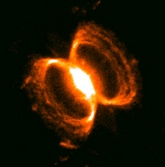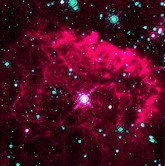The Hidden SF Treasure Box
Posted by hyperpat on May 14, 2008
There’s been a fair amount of discussion lately about a trend in science fiction that has become quite pronounced in the last few years, namely, the near moribund adult sf market and the strong surge in YA sf, as practiced by the likes of Scott Westerfeld, Justine Larbalestier, Garth Nix, and recent entries by the likes of Cory Doctorow. At least some of this has been driven by the fantastic success of the Harry Potter books and movies, which phenomenon has certainly had an influence on young people looking for more of the same. Which at least helps explain why the YA field has enjoyed good sales numbers, but does nothing to explain why adult SF has not enjoyed similar growth – after all, the young teens who cut their teeth on the first Harry Potter book are now in their twenties, and could reasonably be expected to have graduated to more ‘adult’ fare.
But what makes this dichotomy even more puzzling is the fact that YA today is not the YA over-the-hill types like myself grew up with, the Heinleins, Nortons, Asimovs (Paul French), etc. The most obvious difference is that during the day these writers were publishing their ‘YA’ material, any reference to sex was an absolute no-no. Heinlein’s run-ins with his editor at Scribners about this subject are now legendary, and his methods of getting around her very puritanical attitudes are somewhat hilarious – “Raising John Thomases” in The Star Beast, the title of Tunnel in the Sky (TITS), as well as being ingenious. Even back then, the authors writing material for teens were well aware that teens knew what sex was and had very normal concerns and issues about the subject that they wanted to see addressed, but the rules of the day were that sex was an off-limits subject, not ‘appropriate’ material for teens to be reading about, which certainly frustrated the writers.
Nowadays, the subject is not off-limits, though there are still concerns about being too graphic. Most of the better writers in this field today do inject something about it in their works, as after all, teens do think about sex, and presenting characters where this is not even a little part of their lives is highly unrealistic. In some cases, they do much more than indicate that sex exists, but explore in detail the concerns and problems teens face in this area.
But given this new freedom to present teens as more complete, real people, it starts to beggar the question of just what the difference is between YA and adult sf. And for the life of me, I can’t see any difference except YA books have young protagonists, and most often the problems they face involve some aspect of growing up to be mature adults. Vocabulary, situations, scientific detail, concepts, and portrayed societies are seemingly identical between many YA and adult sf books. Except, perhaps, that most YA sf is more accessible and/or relevant to the average reader than a lot of current ‘hard’ sf.
But for whatever reason, YA material is selling better than adult sf, and it is attracting some very competent writers. Those adult sf readers who turn up their noses at such books are, IMO, missing a lot of decent reading, and need to develop the habit of browsing the YA shelves in the bookstores, as most bookstores do not double-shelve in both the YA and SF areas. Perhaps it is just this separation in shelving that might be part of the reason for the disparity in sales and why those reading YA don’t seem to be graduating to the adult section later in life, as they’ve never formed the habit of looking in the SF section, just as the adults quit browsing the YA section a long time ago.
Good writing is good writing, and there’s a lot of it in the YA section. Go give it a look.



wpm1955 said
This is very interesting. I am a teacher in an overseas American school. I teach Grade Three, and have just been introducing my students this year to science fiction. We don’t have a lot in this genre in elementary school, unfortunately. At least we have two versions for kids of H.G. Well’s “The Time Machine.” My kids really enjoyed it. I also showed them the three movies in the “Back to the Future” series.
I think there is FAR too much in the “Realistic” genre, which is of interest to SOME kids, but not MOST kids. Most kids prefer adventure, or mystery/science fiction adventure. I think much of what is in elementary libraries is what ADULTS feel kids should be interested in, and not necessarily what the kids ARE interested in!
Best regards,
Madame Monet
Writing, Painting, Music, and Wine (in Marrakesh, Morocco)
winewriter.wordpress.com
hyperpat said
It was just about at that age (9) when I started stumbling across sf, mainly those works by Heinlein and Asimov. Didn’t tackle Wells or Verne till a couple of years later. Back then (1957), my school library actually had quite a selection of good sf – perhaps because of a librarian who had some idea of what kids that age were really looking for, with adventure and environments far removed from their everyday lives at the top of the list.
But I’m very happy to hear of a teacher who actually introduces kids to sf! During my school years, sf was essentially forbidden in the classrooms, and there were very few teachers who had an opinion of sf that was higher than ‘trash’ (except for those few works that had gotten the nod by the literary academia, such as 1984, Brave New World, and Fahrenheit 451 – none of which are good introductory materials to sf – and of course these weren’t really sf, but rather dystopias, as sf couldn’t be that good).
Bill Green said
This is interesting. I read Neil Gaimen’s “Neverwhere” for example, and thought it was one of the best SF stories I’ve read in a while. I think his stories may be aimed at the young adult audience, so I agree there is a lot of good stuff out there. One thing I’ve observed is that young adult females seem to be okay with the young adult SF, however, try talking about SF to an adult female and you get the “deer in the headlights” look. Perhaps the audience is greater for this type of work than traditional SF because both young males & young females seem to be interested in it.
I think its true that kids are looking for adventure in scifi or a mystery. Really just like any adult story but surrounded by the scifi environment; it engages their imagination.